The crevices in walls provide an opportunity to create a beautiful wall garden but also present challenges. They usually have very little soil and so can dry out or get soggy, depending on the climate. A sunny wall can be even more challenging as temperatures rise but can be an advantage in the spring when the sun warms the wall and encourages new growth. Here are some garden favorites that grow well in the crevices of a sunny wall.
Rock Cress (Arabis caucasica aka A. albida)
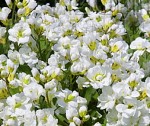 Rock cress is an evergreen herbaceous perennial native to mountainous areas from the Mediterranean to eastern Asia where it grows in well-drained soils and full sun. The low-growing plant forms a loose mat and carries hairy, gray-green basal leaves up to two inches long. The small white flowers have four petals and are carried in loose racemes in early spring. Shearing hard after blooming creates more attractive plants during the summer and enhances the following year’s bloom. Rock cress prefers cool climates and is a good choice for planting in the crevices among rocks or in walls in zones 7 and cooler.
Rock cress is an evergreen herbaceous perennial native to mountainous areas from the Mediterranean to eastern Asia where it grows in well-drained soils and full sun. The low-growing plant forms a loose mat and carries hairy, gray-green basal leaves up to two inches long. The small white flowers have four petals and are carried in loose racemes in early spring. Shearing hard after blooming creates more attractive plants during the summer and enhances the following year’s bloom. Rock cress prefers cool climates and is a good choice for planting in the crevices among rocks or in walls in zones 7 and cooler.
Type: Evergreen herbaceous perennial
Height: 8-10″
Soil: Average, dry to medium moist, well-drained; tolerates drought and infertile soil.
Hardiness: Zones 4-8
Trailing Snapdragon (Asarina procumbens)
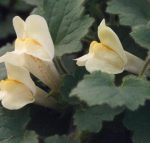 Native to the Spain and Portugal, this procumbent perennial is often grown as an annual. It grows 2-3″ tall and has trailing stems with coarsely toothed, gray-green leaves that are kidney shaped, up to 2″ long, and softly hairy. From summer into fall, 2-lipped, snapdragon-like flowers appear singly in the leaf axils. They are pale yellow with deep yellow throats and light purple veins. Plants grow best where summer temperatures are cool and winters are relatively dry. They are a good choice for containers, a ground cover, and rock and wall gardens.
Native to the Spain and Portugal, this procumbent perennial is often grown as an annual. It grows 2-3″ tall and has trailing stems with coarsely toothed, gray-green leaves that are kidney shaped, up to 2″ long, and softly hairy. From summer into fall, 2-lipped, snapdragon-like flowers appear singly in the leaf axils. They are pale yellow with deep yellow throats and light purple veins. Plants grow best where summer temperatures are cool and winters are relatively dry. They are a good choice for containers, a ground cover, and rock and wall gardens.
Type: Herbaceous perennial often grown as annual
Height: 2-3″
Soil: Average, medium moist, well-drained; dry in winter
Hardiness: Zones 6-9
Photo Credit: Wikimedia Commons
Purple Rock Cress (Aubrieta deltoidea)
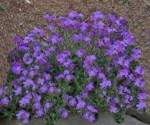 A wildflower native to the Mediterranean and Asia Minor, purple rock cress grows 4-6″ tall and has silvery-green foliage of spoon-shaped to oval leaves that covers rocks and spaces as it spreads forming lovely mounds of vegetation. In spring, the loose clusters of 4-petaled lavender to deep pink flowers are held above the semi- evergreen foliage. Purple rock cress is especially attractive as a ground cover or edger, between stepping stones, in crevices, or spilling over a garden wall or out of a planter. It is a good choice for cottage, Mediterranean, and rock gardens but should be treated as an annual or biennial in the South where it is short lived due to humidity and high night temperatures.
A wildflower native to the Mediterranean and Asia Minor, purple rock cress grows 4-6″ tall and has silvery-green foliage of spoon-shaped to oval leaves that covers rocks and spaces as it spreads forming lovely mounds of vegetation. In spring, the loose clusters of 4-petaled lavender to deep pink flowers are held above the semi- evergreen foliage. Purple rock cress is especially attractive as a ground cover or edger, between stepping stones, in crevices, or spilling over a garden wall or out of a planter. It is a good choice for cottage, Mediterranean, and rock gardens but should be treated as an annual or biennial in the South where it is short lived due to humidity and high night temperatures.
Type: Evergreen perennial
Height: 4-6″
Soil: Average, light, well drained
Hardiness: Zones 4-8
Basket of Gold (Aurinia saxatalis)
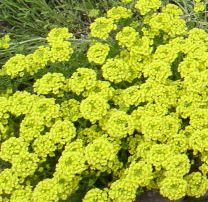 A native of central and southeastern Europe, basket-of-gold is an evergreen perennial also known as yellow alyssum, madwort, goldentuft, and gold-dust. Growing 6-12″ tall, it has simple grey-blue spatulate leaves up to 5″ long and corymboe panicles of small bright yellow flowers in spring that contrasts nicely with the foliage. Basket of gold is fairly drought resistant when established but unfortunately languishes in high heat and humidity and tends to be short lived in such climates. It is best treated as an annual in the South. Good in rock and wall gardens, as edging, or as filler in a border.
A native of central and southeastern Europe, basket-of-gold is an evergreen perennial also known as yellow alyssum, madwort, goldentuft, and gold-dust. Growing 6-12″ tall, it has simple grey-blue spatulate leaves up to 5″ long and corymboe panicles of small bright yellow flowers in spring that contrasts nicely with the foliage. Basket of gold is fairly drought resistant when established but unfortunately languishes in high heat and humidity and tends to be short lived in such climates. It is best treated as an annual in the South. Good in rock and wall gardens, as edging, or as filler in a border.
Type: Evergreen perennial
Height:6-12″
Soil: Average, moderately moist to dry, well-drained
Hardiness: Zones 3-7
Mountain Avens (Dryas octopetala)
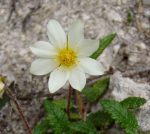 Also known as eightpetal mountain-avens, creeping oak, white dryas, or white dryad, this prostate evergreen subshrub is a circumpolar species found in the arctic tundra of northern Eurasia and North America and extending into the mountain of the Cascades and Rocky Mountains above tree line as far south as Colorado. Growing 2.5-4″ tall, the plant forms a large mat 2-3′ across with woody stems and small, green, leaves that have scalloped margins, a smooth upper surface and woolly, matted hairs beneath. From late spring into summer, leafless stalks carry anemone-like flowers 6-8″ above the foliage. The flowers usually have 8 white petals surrounding a yellow center, but some flowers have up to 16 petals. An attractive seed head with silky feathery hairs persist into fall. Mountain avens is a good choice for a ground cover or alpine, rock, or wall gardens.
Also known as eightpetal mountain-avens, creeping oak, white dryas, or white dryad, this prostate evergreen subshrub is a circumpolar species found in the arctic tundra of northern Eurasia and North America and extending into the mountain of the Cascades and Rocky Mountains above tree line as far south as Colorado. Growing 2.5-4″ tall, the plant forms a large mat 2-3′ across with woody stems and small, green, leaves that have scalloped margins, a smooth upper surface and woolly, matted hairs beneath. From late spring into summer, leafless stalks carry anemone-like flowers 6-8″ above the foliage. The flowers usually have 8 white petals surrounding a yellow center, but some flowers have up to 16 petals. An attractive seed head with silky feathery hairs persist into fall. Mountain avens is a good choice for a ground cover or alpine, rock, or wall gardens.
Type: Evergreen subshrub
Height:2.5-4″
Soil: Average, medium m oist, well-drained
Hardiness: Zones 2-8
Photo Credit: Wikimedia
Fairy’s Thimble ( Campanula cochleariifolia aka C. pusilla)
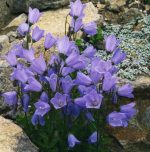 Also known as spiral and earleaf bellflower, this rhizomatous herbaceous perennial is native to the mountains of Europe including the Pyrenees, Alps, and Carpathian where it grows in the cracks in the rocks. Plants form spreading mats of bright green nearly round leaves and produce clusters of nodding 3/4″ diameter blue-violet flowers on wiry stems in summer. Fairy’s thimble is an excellent choice for the front of the border, containers, along pathways, or in a rock garden, wall garden, or cottage garden.
Also known as spiral and earleaf bellflower, this rhizomatous herbaceous perennial is native to the mountains of Europe including the Pyrenees, Alps, and Carpathian where it grows in the cracks in the rocks. Plants form spreading mats of bright green nearly round leaves and produce clusters of nodding 3/4″ diameter blue-violet flowers on wiry stems in summer. Fairy’s thimble is an excellent choice for the front of the border, containers, along pathways, or in a rock garden, wall garden, or cottage garden.
Type: Herbaceous perennial
Height: 4-6″
Soil: Average, medium moist, well-drained
Hardiness: Zones 6-7
Photo Credit:Ghislain-118-Wikimedia-Commons
Fairy Foxglove (Erinus alpinus)
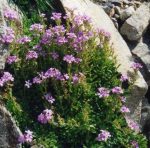 Native to Central and Southern Europe, this semi-evergreen perennial is also known as alpine balsam, starflower, and liver balsam. It is a member of the plantain family, Plantaginaceae, that also includes snapdragon, turtlehead, and Veronica. Plants grow 2-3″ tall and form neat rosettes of blue-green, spoon-shaped leaves. In late spring and summer plants produce ascending leafy stems with terminal clusters of small, starry, pale purplish pink to white flowers. Although the plants are short-lived they self seed in favorable conditions. Fairy foxglove like dry conditions and is a good choice for screes, containers, as well as alpine, rock, and wall gardens.
Native to Central and Southern Europe, this semi-evergreen perennial is also known as alpine balsam, starflower, and liver balsam. It is a member of the plantain family, Plantaginaceae, that also includes snapdragon, turtlehead, and Veronica. Plants grow 2-3″ tall and form neat rosettes of blue-green, spoon-shaped leaves. In late spring and summer plants produce ascending leafy stems with terminal clusters of small, starry, pale purplish pink to white flowers. Although the plants are short-lived they self seed in favorable conditions. Fairy foxglove like dry conditions and is a good choice for screes, containers, as well as alpine, rock, and wall gardens.
Type: Semi-evergreen perennial
Height: 2-3″
Soil: Average, dry to medium moist, well-drained
Hardiness: Zones 4-7
Photo Credit Wikipedia
Rock Knotweed (Persicaria vaccinifolia)
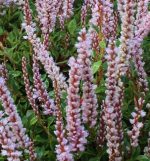 An Himalayan native, this semi-evergreen perennial is also called whortleberry-leaved knotweed and creeping fleece flower. Growing 6-12″ tall, it forms a dense mound of reddish stems carrying small glossy, ovate leaves that have red and gold tints in the fall. In late summer to early fall slender stems carry dense spikes or red to pink flowers. Rock knotweed is an excellent choice for a ground cover, edger, border, rock or wall garden. It flowers best in areas with cool evening temperatures.
An Himalayan native, this semi-evergreen perennial is also called whortleberry-leaved knotweed and creeping fleece flower. Growing 6-12″ tall, it forms a dense mound of reddish stems carrying small glossy, ovate leaves that have red and gold tints in the fall. In late summer to early fall slender stems carry dense spikes or red to pink flowers. Rock knotweed is an excellent choice for a ground cover, edger, border, rock or wall garden. It flowers best in areas with cool evening temperatures.
Type: Semi-evergreen perennial
Height: 6-12″
Soil: Average, medium moist to dry, well-drained
Hardiness: Zones 6-8